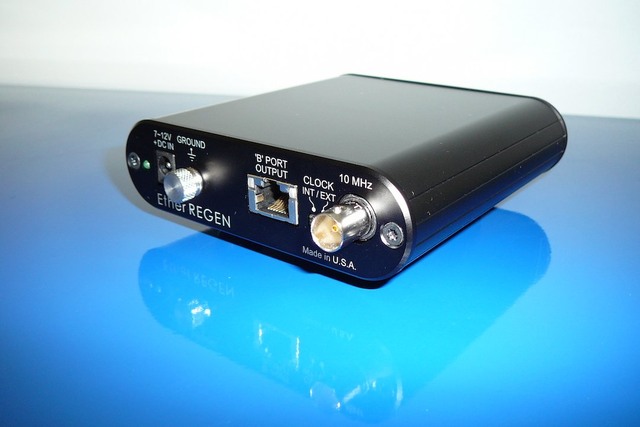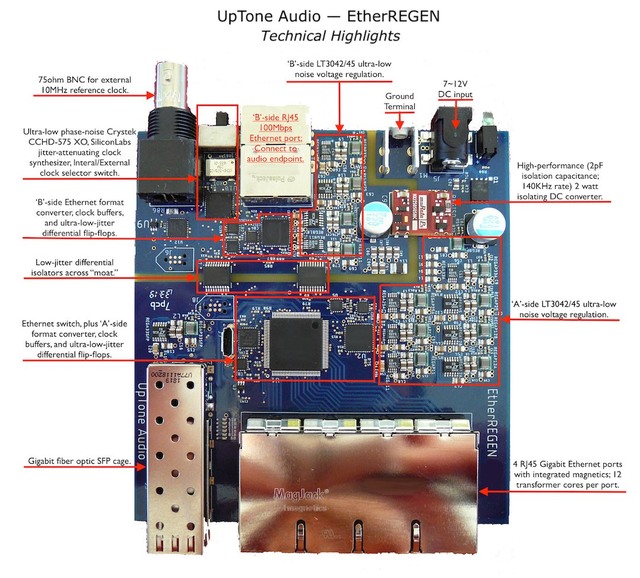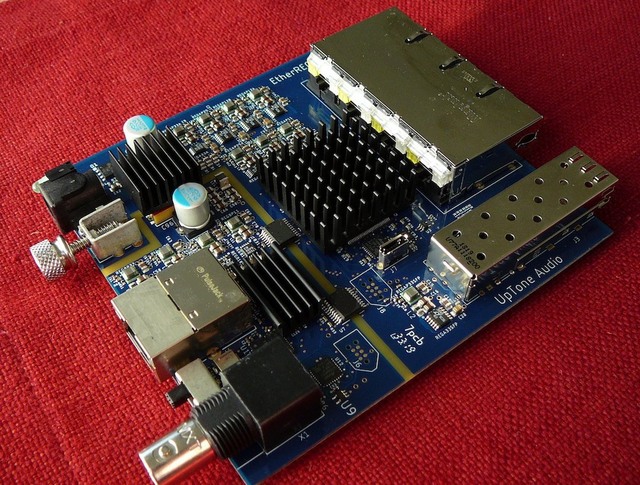Puma Cat
Well-known member
- Thread Author
- #1
Last week, Uptone Audio released their newest product, the EtherREGEN, a ground-up designed audiophile-grade Ethernet switch that has been in development for over 18 months.
When sales went live October 8th, the first 155 domestically avaiable units were sold in...3 minutes. The second run of ~200 sold out in less in another 45 minutes or so. Those that were able to get into the first group will receive their EtherREGENS around 10 November or so.

From Uptone:
Other “audiophile” Ethernet switches are mostly either just clock and power supply modifications of cheap off-the-shelf switches, or passive magnetics augmented with passive filter parts and a single fancy clock board.
EtherREGEN is an all-new, from the ground-up design, built on a costly 6-layer circuit board, and its components and topology are unmatched by any other Ethernet switch.
The heart of what makes our switch so unusual is the use of ACTIVE, HIGH-SPEED, LOW-JITTER DIFFERENTIAL DIGITAL ISOLATOR chips combined with ULTRA-LOW JITTER DIFFERENTIAL RE-CLOCKING FLIP-FLOPS. No other Ethernet switch on the market attempts this (doing this, and doing it correctly is neither easy nor cheap!). On the circuit board photos you can see the isolators set across the wide “moat.”

More information:
On the ‘A’-side, there are 4 Gigabit copper Ethernet ports, plus an SFP cage for a Gigabit LC optical module. A typical user will attach a cable from their main network router or switch, and if desired any NAS (network attached storage) or other devices.
Across the “moat” at the other end of the EtherREGEN is a lone 100Mbps copper Ethernet port. This is referred to as the ‘B’-side port. It is to this port that the user will attach whatever is their one computer/streamer/bridge/renderer endpoint—the component that is directly connected to the DAC (this includes the increasing number of DACs which themselves have an Ethernet input).
So why does this arrangement matter? From Uptone:
There are two types of sound-degrading influences the EtherREGEN is designed to radically decrease: Leakage—both high-impedance and low-impedance—and clock phase-noise. The clock phase-noise travels on the Ethernet signal itself and travels on power and ground planes. [Every edge coming out of any digital device caries the jitter/phase-noise of the clock used to "clock out" that edge, this shows up on the ground-plane and affects the threshold of chips’ clock inputs. This is an oversimplification of a complex subject; we intend to publish a short white paper and measurements to demonstrate this.]
The circuitry across the moat is designed to eliminate the signal-borne phase-noise from one side to the other. EtherREGEN is mostly symmetrical—there is no “dirty side” or “clean side.” While it works identically in both directions, it is best to have the DAC-attached Ethernet endpoint device (computer/streamer/etc.) alone on one side—typically the ‘B’ side.
The circuitry between ports on the ‘A’ side decreases some phase-noise effects to some degree, but not nearly as much as crossing the ‘A’>’B’ moat.
The COMBINATION of the differential isolators and the differential flip-flops is what delivers the unrivaled performance of the EtherREGEN. The differential isolators prevent the data-borne clock signature from getting onto the PCB ground-plane, while the differential flip-flops prevent the signature from getting into the flip-flop’s own internal ground network. It takes both to accomplish the great feats of the EtherREGEN.
Some key technical features from Uptone's web page:

I ordered mine at 9:03 AM on Oct. 8, so I got into the 2nd group and will receive my EtherREGEN some time around Dec. 10th. Price is only $640, which is considerably less expensive than the AQVOX and SOtM Ethernet audiophile-grade Ethernet switches.
If you use an Ethernet switch in your digital front-end, and are interested in getting an EtherREGEN, I recommend you place an order immediately. If you're lucky, you may get into the January 2020 production shipment.
My expectation is EtherREGEN will be the best-sounding Ethernet switch on the market given its BOM and the technical & domain expertise that went into its design by John Swenson.
When sales went live October 8th, the first 155 domestically avaiable units were sold in...3 minutes. The second run of ~200 sold out in less in another 45 minutes or so. Those that were able to get into the first group will receive their EtherREGENS around 10 November or so.

From Uptone:
Other “audiophile” Ethernet switches are mostly either just clock and power supply modifications of cheap off-the-shelf switches, or passive magnetics augmented with passive filter parts and a single fancy clock board.
EtherREGEN is an all-new, from the ground-up design, built on a costly 6-layer circuit board, and its components and topology are unmatched by any other Ethernet switch.
The heart of what makes our switch so unusual is the use of ACTIVE, HIGH-SPEED, LOW-JITTER DIFFERENTIAL DIGITAL ISOLATOR chips combined with ULTRA-LOW JITTER DIFFERENTIAL RE-CLOCKING FLIP-FLOPS. No other Ethernet switch on the market attempts this (doing this, and doing it correctly is neither easy nor cheap!). On the circuit board photos you can see the isolators set across the wide “moat.”

More information:
On the ‘A’-side, there are 4 Gigabit copper Ethernet ports, plus an SFP cage for a Gigabit LC optical module. A typical user will attach a cable from their main network router or switch, and if desired any NAS (network attached storage) or other devices.
Across the “moat” at the other end of the EtherREGEN is a lone 100Mbps copper Ethernet port. This is referred to as the ‘B’-side port. It is to this port that the user will attach whatever is their one computer/streamer/bridge/renderer endpoint—the component that is directly connected to the DAC (this includes the increasing number of DACs which themselves have an Ethernet input).
So why does this arrangement matter? From Uptone:
There are two types of sound-degrading influences the EtherREGEN is designed to radically decrease: Leakage—both high-impedance and low-impedance—and clock phase-noise. The clock phase-noise travels on the Ethernet signal itself and travels on power and ground planes. [Every edge coming out of any digital device caries the jitter/phase-noise of the clock used to "clock out" that edge, this shows up on the ground-plane and affects the threshold of chips’ clock inputs. This is an oversimplification of a complex subject; we intend to publish a short white paper and measurements to demonstrate this.]
The circuitry across the moat is designed to eliminate the signal-borne phase-noise from one side to the other. EtherREGEN is mostly symmetrical—there is no “dirty side” or “clean side.” While it works identically in both directions, it is best to have the DAC-attached Ethernet endpoint device (computer/streamer/etc.) alone on one side—typically the ‘B’ side.
The circuitry between ports on the ‘A’ side decreases some phase-noise effects to some degree, but not nearly as much as crossing the ‘A’>’B’ moat.
The COMBINATION of the differential isolators and the differential flip-flops is what delivers the unrivaled performance of the EtherREGEN. The differential isolators prevent the data-borne clock signature from getting onto the PCB ground-plane, while the differential flip-flops prevent the signature from getting into the flip-flop’s own internal ground network. It takes both to accomplish the great feats of the EtherREGEN.
Some key technical features from Uptone's web page:
- EtherREGEN has two entirely isolated data/power/clock domains. And on each side of the isolators we re-clock with 10GHz-capable ultra-low-jitter (less than 0.8 picoseconds) differential flip-flops.
- Importantly, all clocking lines (for the switch chip, the special Ethernet format conversion chips, and the high-speed flip-flops) are carefully run as differential lines—converted to single-ended clocks with special buffers just millimeters from those chips which require SE clocks.
- The clocking system runs from a special programmable, jitter-attenuating four-output clock synthesizer, referenced to an ultra-low-jitter/phase-noise Crystek CCHD-575 XO.
- Even the magnetics of the 4 Gigabit ‘A’-side ports are special.
- We chose a module which utilizes 12 transformer cores in each port (most Ethernet ports have 2-6 cores), and ground their center-taps through capacitors in a way that blocks port-to-port AC leakage.

- To support its performance, the power networks of the EtherREGEN are as sophisticated and costly as the rest of the design. We use 12 of the world’s lowest-noise, lowest impedance integrated voltage regulators—the famous Linear Technology LT3045 and LT3042. Supporting both the voltage regulators and the data chips are 195 pieces of low-inductance, X7R and X5R capacitors sized and selected by their derating curves.

I ordered mine at 9:03 AM on Oct. 8, so I got into the 2nd group and will receive my EtherREGEN some time around Dec. 10th. Price is only $640, which is considerably less expensive than the AQVOX and SOtM Ethernet audiophile-grade Ethernet switches.
If you use an Ethernet switch in your digital front-end, and are interested in getting an EtherREGEN, I recommend you place an order immediately. If you're lucky, you may get into the January 2020 production shipment.
My expectation is EtherREGEN will be the best-sounding Ethernet switch on the market given its BOM and the technical & domain expertise that went into its design by John Swenson.






